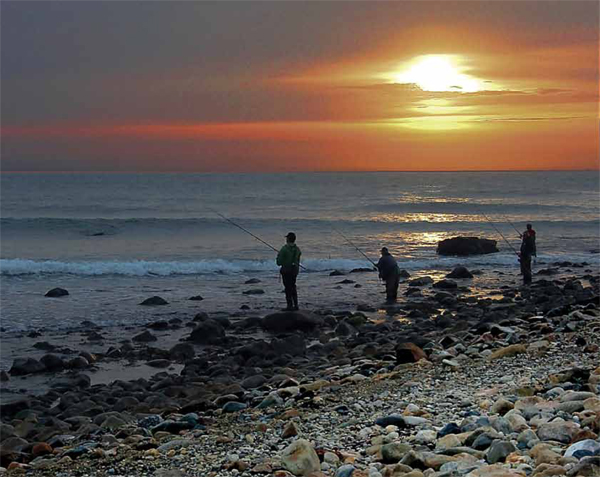
Sunset at Montauk Point. Photo by Michael Weinberg.
The New York dawn comes earliest to Montauk, where surfcasters know the thrill of throwing out their first line at first light. Nearby, the dock on the inlet is humming with activity as fishing boats head out before the sun is up. The captain is heartened knowing that his crew is prepared for whatever weather comes their way. Each of the crew has attended last summer’s Safety-at-Sea workshop organized by New York Sea Grant and has practiced putting on a life-saving immersion suit. “I’d rather learn how to put it on in June on the dock than in February out at sea,” said one 27-year veteran fisherman. The captain is aiming for an early return so the day’s iced catch can be loaded and trucked to Fulton Fish Market for the next day’s predawn auction.
Early in the day, too, about 400 miles away in the middle of Lake Ontario, enthusiastic educators work side-by-side with environmental researchers, taking samples, monitoring water quality and checking for native and invasive species during a week-long research cruise. Once back in the classroom, the teachers will show the next generation what it means to best preserve and secure our aquatic resources. Recreational and commercial fishermen, seafood businesses, municipalities, researchers and educators—these are some of the important stakeholders that are served by New York Sea Grant, now in its 40th year of Bringing Science to the Shore.
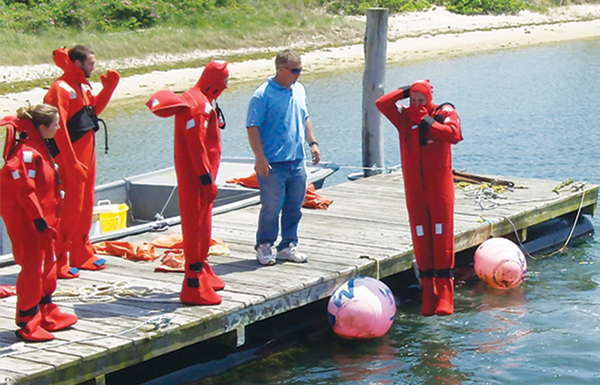 Commercial fishermen don immersion suits at Safety-at-Sea training, Montauk. Photo by Paul Focazio. Safety-at Sea is partnership of NYSG’s Antoinette Clemetson, the Coast Guard and others.
Commercial fishermen don immersion suits at Safety-at-Sea training, Montauk. Photo by Paul Focazio. Safety-at Sea is partnership of NYSG’s Antoinette Clemetson, the Coast Guard and others.
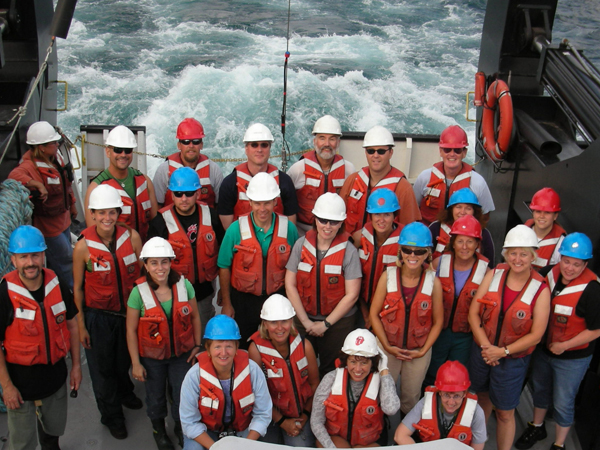 Teachers and scientists aboard R/V Lake Guardian. Photo by NYSG Paul Focazio.
New York Sea Grant is born
Teachers and scientists aboard R/V Lake Guardian. Photo by NYSG Paul Focazio.
New York Sea Grant is born
It was the sixties. Our nation was in the throes of social upheaval paired with unprecedented scientific advances. Rachel Carson’s book, Silent Spring, had begun to raise our awareness about the environment. Many proclaimed Lake Erie to be dead. Our nation’s technological machinery was moving at a breakneck pace ever since President John Kennedy challenged Americans to put a man on the moon by decade’s end. But compared to the space race, ocean exploration was back at the starting gate.
Things were about to change. At the 1963 meeting of the American Fisheries Society, keynote speaker Althestan Spilhaus, a University of Minnesota professor, first mentioned the concept of “Sea Grant colleges” along the same lines as historical Land Grant colleges. “The same kind of imagination and foresight should be applied to the exploration of the sea,” said Spilhaus in a 1964 issue of Science. In 1966, the National Sea Grant College Program was born by Act of Congress with a goal of initiating and supporting education, research and outreach programs to impart useful information to people working with marine resources, the scientific community and the general public.
By decade’s end, a number of states became eligible for funding under the National Sea Grant College Act, states with coasts along not only the Atlantic and Pacific, but the Great Lakes, our continent’s inland seas. New York, with its unique location, borders the Atlantic Ocean and two of the Great Lakes--Erie and Ontario--and contains the interconnecting river systems of the Hudson, Niagara and St. Lawrence. On November 1, 1971, The New York Times ran the headline “New York Sea Grant Program Receives Initial Funding.” New York State had just received its first $600,000 grant under the new National Sea Grant Program and funding would be used to explore development of the state’s thousands of miles of coastlines along the Atlantic Ocean, Lakes Erie and Ontario. Dr. Donald F. Squires at the State University at Stony Brook would head the program, starting a long tradition of choosing only the best high quality research projects and disseminating the results through a specialized extension staff. Today’s forward-thinking goals revolve around the themes of healthy coastal ecosystems, sustainable coastal development, safe and sustainable seafood, and hazard resilience in coastal communities.
The New York program evolved as a cooperative program of the State University of New York (SUNY) and Cornell University, the state’s federally designated Land Grant College, with offices and personnel across the state. The New York Sea Grant program is one of 32 designated programs federally funded under the National Oceanic and Atmospheric Administration (NOAA) within the Department of Commerce.
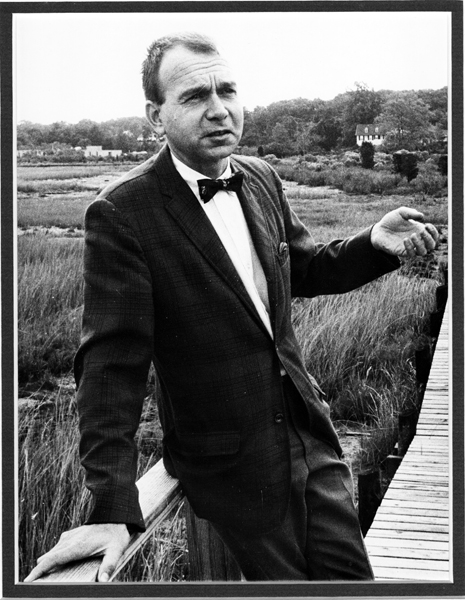
Dr. Donald F. Squires attends the opening of the Flax Pond Laboratory near Stony Brook on Long Island’s north shore. In 1971, as the first director of the newly formed Marine Science Research Center at Stony Brook University, Dr. Squires announced a proposal to establish a Sea Grant College there.

Scholars on the Sound then and now: Long Island Sound is an estuary of national significance. These graduate students doing a “grab” of bottom sediment were funded by New York Sea Grant in the 1970s. Forty years later, Bill Wise (left) is the Associate Director of the School of Marine and Atmospheric Sciences at Stony Brook University and Karen Chytalo is the Assistant Bureau Chief of the NYSDEC Bureau of Marine Resources. According to longtime NYSG Assistant Director, Cornelia Schlenk, NYSG has provided upwards of $11 million in fellowship funding support for the technical training of more than 600 graduate students working on issues related to our coastal resources.
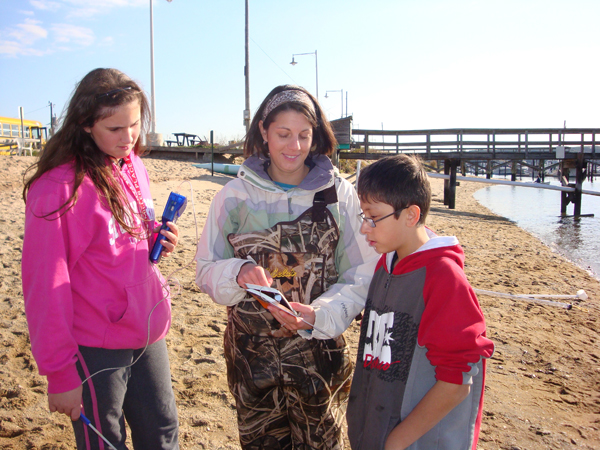
Today, NYSG’s Larissa Graham, Long Island Sound outreach coordinator, supervises Sound Stewards who monitor water quality and habitat restoration projects. It’s the next generation’s turn at stewardship. Photo courtesy of North Country Middle School, Miller Place, NY,
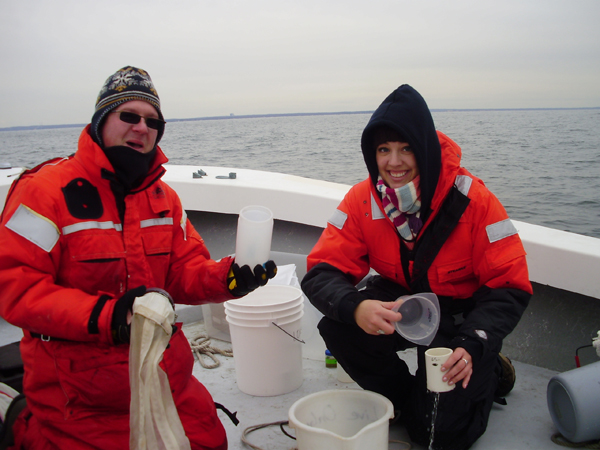
Graduate students sample Long Island Sound during the winter to help discover some of the causes of oxygen loss in the summer. Throughout Long Island, Eileen Keenan, NYSG NEMO Program Manager, assists coastal communities in mitigating the impacts of polluted stormwater runoff. Photo by Jennifer George
Research to Application: The Sea Grant Paradigm
Since its inception, New York Sea Grant has brought high quality research right to the end user with a useful application—or as we call it “bringing science to the shore.” One early 1971 project looked at ice cover on Lake Erie, resulting in an expansion of the winter navigability of the lake. Other projects from that decade examined the impacts of hard structures along shorelines—breakwaters and power plants. Funding was used to study the fisheries throughout the state and to comprehensively survey the New York Bight for the first time. From some of the state’s leading academic institutions, Sea Grant brought together researchers trained in related fields—fish biologists and physical oceanographers, coastal engineers and toxicologists, geochemists and social scientists. Then a cadre of trained extension staff would disseminate the research results to angler groups, managers, government officials and educators.
Extension staff is the first to hear about emerging issues from stakeholders and the first to respond with important technical information and resources. In the 1980s, when the threat of invasive zebra mussels in New York’s Great Lakes became apparent, New York Sea Grant Extension “got ahead of the issue” and led workshops throughout the region, informing stakeholders how they might prevent and reduce negative impacts to the resources they valued. More recently, Dr. Paul Bowser of Cornell’s College of Veterinary Medicine has been conducting research on the VHS virus, a potentially deadly virus that threatens Great Lakes fish. He worked closely with NYSG’s fisheries specialist, Dave MacNeill to bring information about the virus to anglers and aquaculturists. Together they won the first-ever Research to Application Award given by the national Sea Grant Association for their coordinated efforts in spreading the word about the VHS virus.
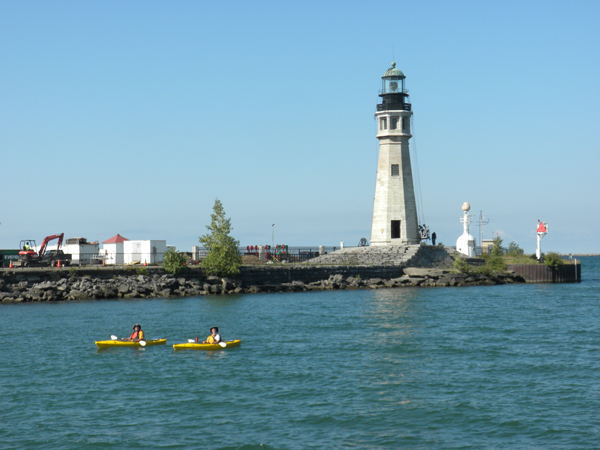
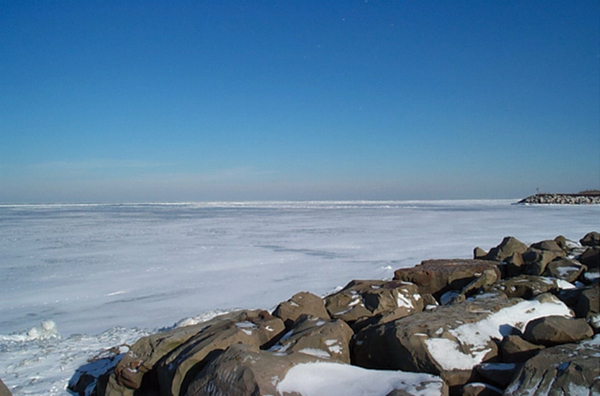
Lake Erie scenics in summer and winter, by NYSG Paul C. Focazio, Helen Domske
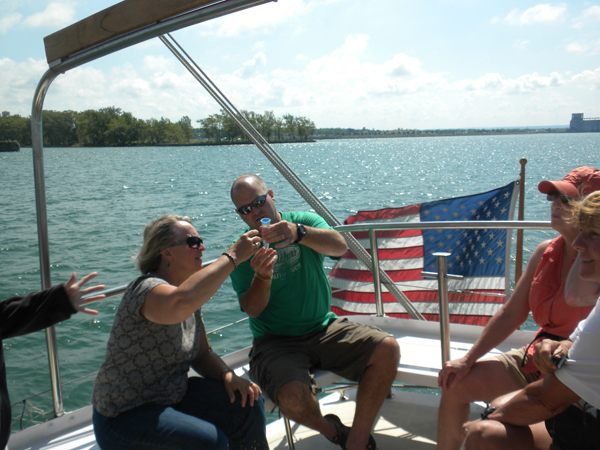
Lake Erie workshop by NYSG Paul Focazio. Ensuring a scientifically and environmentally informed citizenry for the future is a New York Sea Grant priority. Educators gather at a recent Lake Erie workshop where they learn about lake fish and changes in the ecosystem due to invasive species. By “teaching the teachers,” NYSG coastal educator Helen Domske can reach 45,000 students a year.
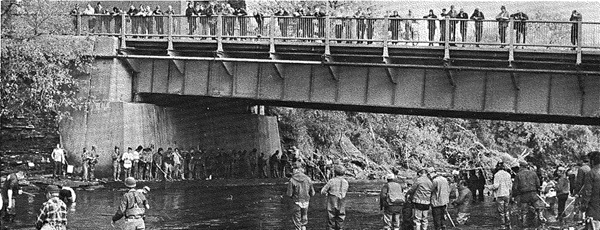
Archive panoramic photo of fishermen on the Salmon River , NYSDEC
Along the Salmon River, fishermen lined up almost shoulder to shoulder were assisted by New York Sea Grant “agents in hip waders” back in the 1970s—as described by the late Bruce Wilkins, who led the New York Sea Grant Extension program in the early days. Today, fisheries specialist Dave MacNeill extends NYSG research on trout and salmon as he has done for the last two decades. “Sea Grant, NYSDEC and USGS have complementary missions.” says Dave. “NYSG sponsors research that NYSDEC uses to better manage our valuable fisheries.
The U.S. Geological Survey (USGS), in close collaboration with NYSDEC, is also a key player in conducting fish assessment to measure population trends of important prey fish. Most NYSG sponsored research on the Lower Great Lakes would not be possible if it weren’t for the large research vessels operated jointly by USGS and NYSDEC. Collectively these three agencies often work with the same audiences and rely on each other to take information to the public on emerging issues such as fish health, fish population trends, and new tools to measure fish abundance. NY Sea Grant plays a key role in developing effective communication strategies and identifying ongoing research needs. The three groups are strongly committed to ensuring healthy and sustainable ecosystems and working together to bring accurate, science-based, practical information to resource users so they better understand fisheries management and can make informed decisions.
New York Sea Grant research has been moving steadily towards an ecosystem approach. In Lake Ontario, for example, the core of understanding is the relationships within the food web. The top predator trophy fish, Chinook salmon, consume smaller bait fish, alewife, which in turn consume small planktonic invertebrates. But when species from other environments began invading the Great Lakes—and now there are about 180 invasive species—the ecosystem began to change, as more food energy was intercepted away from native members of the food web by the prolific invaders such as zebra and quagga mussels. In response, NYSG has funded research on all parts of the ecosystem. Part of the job of Sea Grant extension is to build understanding of Lake Ontario’s complicated dynamics by its diverse stakeholders which include anglers, managers, recreational divers, boaters, and those concerned with a safe supply of drinking water.
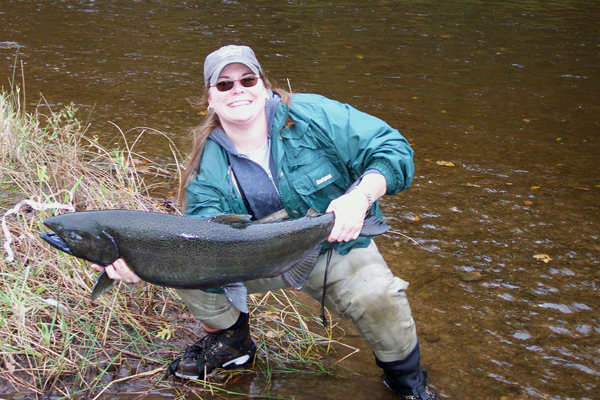
Today, New York Sea Grant extension’s Mary Penney has supervised steward programs along the Salmon River as well as the eastern shore of Lake Ontario.
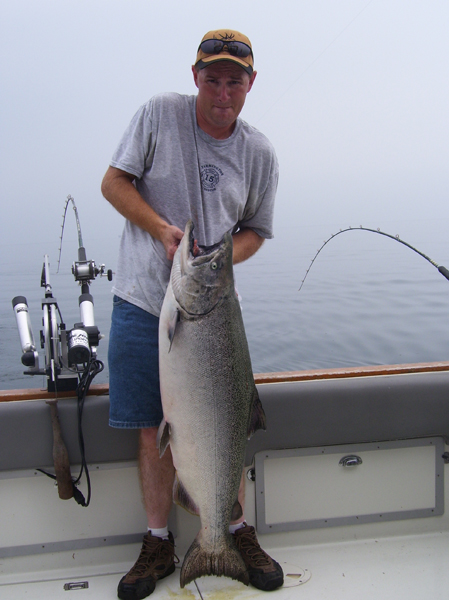
Over the years, NYSG has funded research on Lake Ontario's ecosystem, including its fish communities. This trophy Lake Ontario Chinook was caught in Orleans County. Photo credit Paul Czarnecki.
Establishing Partnerships
For many New Yorkers, be they anglers, divers, or just sun worshippers, fishing and boating go hand in hand. A statewide New York Sea Grant survey on recreational boating expenditures showed that learning about environmentally sound boating practices was important to nearly 90 percent of respondents. Working with a whole host of agency, industry and community partners, NYSG’s recreation/ tourism specialist Dave White brought a pilot project to educate boaters to fruition over the last two years. A fully equipped Discover Clean and Safe Boat visited nearly a dozen events in the Great Lakes in the summer of 2011, demonstrating to boaters all the latest in required boating gear that is both safe and environmentally friendly. During the summer of 2010, more than 1,400 boaters pledged to be “clean and safe” with thousands more exposed to good boating practices. Through the successful 2011 campaign with an emphasis on aquatic invasive species, boaters learned to “Stop aquatic hitchhikers” as well as information about water quality, the changing food web, and safety and security on the water. Added to the mix was a technique familiar to extension – getting the word out which Dave, a 27-year NYSG veteran, also does via TV and radio appearances.
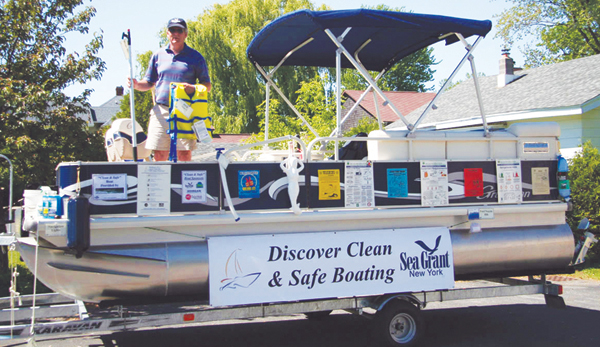
Dave White and the Clean and Safe Boat
The Discover Clean and Safe Boating campaign also reached the scenic Hudson Valley, a region known for its majestic views and historic landmarks. This unique tidal estuary is a living laboratory with fresh water coming from the north mixing with salt water coming up from New York Harbor. Sea Grant has long supported cutting-edge research on once-plentiful river sturgeon. By analyzing the DNA in a tiny snippet of dorsal fin, researchers have identified the genetic markers that make Hudson River sturgeon different from sturgeon from other estuaries along the Atlantic. The techniques developed have helped determine which populations are threatened or endangered and has aided in rebuilding stocks. Other NYSG research runs the gamut from geosciences--how sediments are carried in the river--to the social sciences—surveying those characteristics that make the region a tourist destination.
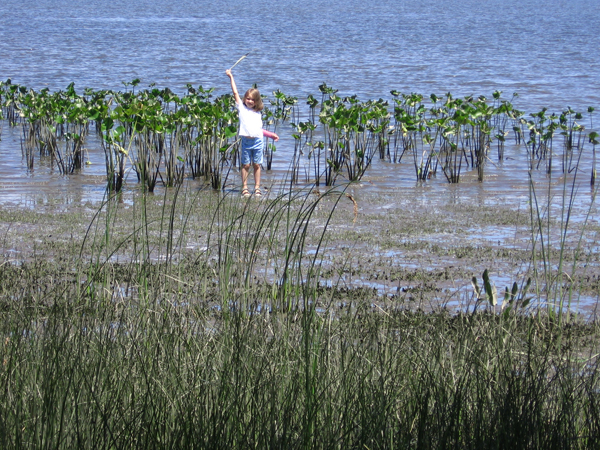
The scenic Hudson by Nordica Holochuck
Ensuring Seafood Safety
With a trip down the scenic Hudson, we arrive at the newly-relocated Fulton Fish Market in New York City where fish caught at Montauk, the Great Lakes, or flown in from anywhere in the world might be ready for sale. A safe and sustainable seafood supply is part of the Sea Grant mission nationwide. And with a good part of the nation’s seafood supply coming through New York, NYSG seafood specialist Ken Gall is an internationally recognized educator in training seafood business owners and inspectors on the scientific ways of keeping seafood fresh. Through workshops or over the Internet, during the last decade over 5700 people have received this important training.
Maybe you’ve noticed in your local fish market, fin fish and shellfish are displayed in different counters. That is because of the difference in temperature at which different types of seafood are kept fresh. Clams from Great South Bay, scallops from Peconic Bay and lobsters from Long Island Sound are all shellfish that have enjoyed popularity and an important place in the New York economy. (Overall, seafood has a $7.9 billion impact on the state’s economy according to a NYSG study.) Yet each of these important marine resources has dwindled—perhaps caused in part by changing water temperature and the prevalence of new organisms establishing a niche in the food web. NYSG research strives to address such questions. Studies of brown tide and its devastating effects on commercially important species such as hard clams and scallops have been an important part of New York Sea Grant’s coordinated research agenda. Beneficial collaborations with other agencies and stakeholders have resulted in an increased understanding of the brown tide alga.
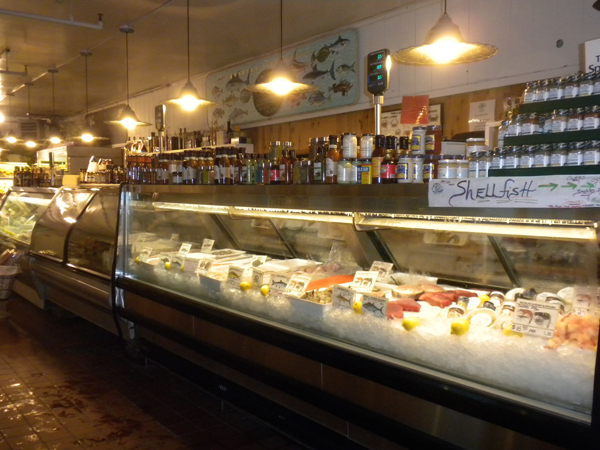
Seafood display by NYSG Barbara Branca . One of NYSG's missions is to ensure seafood safety, including training businesses in the safest and healthiest ways to store and display finfish and shellfish.
A Look to the Future
Some of the same factors that are changing our ecosystems are also affecting our coastal communities more broadly. At the Battery at the “foot” of Manhattan in New York City, the Stony Brook University Storm Surge group is looking at trends in storm surge and the area’s vulnerability to flooding events. They’ve created new models and come up with innovative ideas on how to protect the shoreline and its coastal communities. These Sea Grant funded researchers provided valuable predictions regarding August 2011’s tropical storm Irene to the public through the media.
As New York Sea Grant coastal processes specialist Jay Tanski notes, “While hurricanes get more attention, winter storms known as northeasters (or nor’easters) are more frequent, longer lasting, and much larger than hurricanes, and cause more damage on New York’s coast.” To help coastal communities deal with nor’easters, New York Sea Grant worked with its partners to develop a Web site that helps government officials, coastal managers, and emergency personnel better prepare for predicted storms. “It is being put to good use,” said one emergency manager. And that is exactly New York Sea Grant’s goal—to put the research to good use.
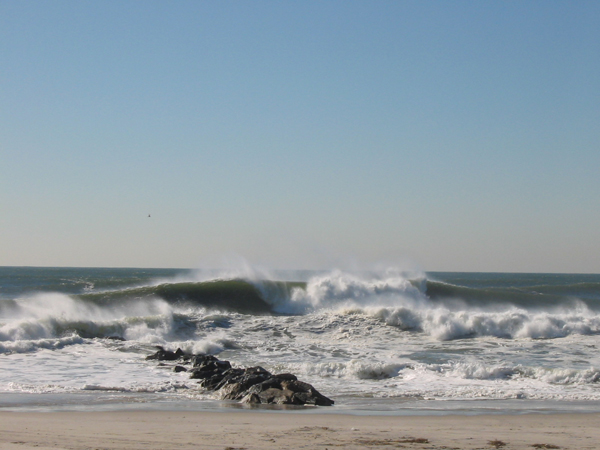
Waves along Long Beach. Waves cause by Nor’easters pummel the south shore of Long Island causing more frequent damage than hurricanes. New York Sea Grant research develops better models for forecasting flooding events and predicting wave action, bringing this potentially life-saving information to coastal managers and emergency agencies. Photo by Frank Buonaiuto
Go to New York Sea Grant’s Web site,
nyseagrant.org, to find out about up to the minute, cutting edge research on topics from algae to zebra mussels. Use our online searchable research database or find out the latest outreach activities on our social media like
Facebook or
Twitter. What’s in store for the next 40 years is anyone’s guess, but New York Sea Grant will surely have the appropriate communications tools.
Barbara Ann Branca is New York Sea Grant’s Communications Manager.